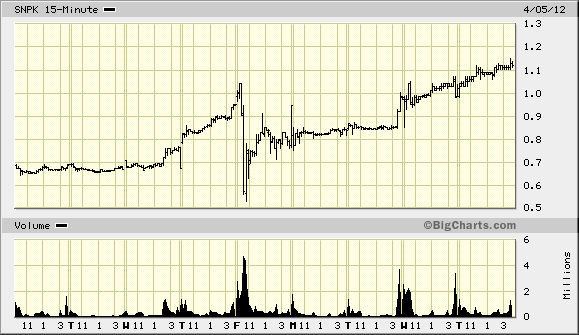In the last post on SNPK (SunPeak Ventures) http://wp.me/p1PgpH-z5 we discussed toxic convertibles (“Death Spiral Converts”). Since then, the price has doubled as the email blasts and press releases pour forth, “MASSIVE upmove, ROCKET price rise, TO THE MOON, Next Price targe, $5!” I am missing out on SPECTACULAR gains!!! When I went to do my typical company visit, all I found was a P.O. Box on Long Island.
For a more detailed analysis of how the scam works: http://investorshub.advfn.com/boards/read_msg.aspx?message_id=73392869#
In a nutshell, various promoters receive “free” stock and then sell on the price rise as the fools rush in.
SNPK was set up from day one to put shares that cost next-to-nothing into the hands of undisclosed insiders using Panamanian based business entities with hired officers as a front so that these insiders could dump their shares during a paid promotion and make out with millions of dollars in profits.
These Panamanian based business entities have extremely strong links to Eric Van Nguyen’s promotional companies leaving this poster very confident that Eric Van Nguyen and others close to him may really control the shares being held in the name of the anonymous Panamanian based entities.
Awesomepennystocks only wants you to buy SNPK shares so those Panamanian based entities can sell their shares. The company started spewing press releases at the same time as the paid promotion started. The company is involved in helping with the insider enrichment scheme. SNPK sold those shares for pennies to those Panamanian based entities then forward split those shares 45:1 to increase the profits made from the selling of those shares.
The plan is to haul in profits while illegally manipulating the stock through promotional spam and wash trading, eventually leaving a bunch of gullible impressionable bag holders in their wake. The recently confirmed involvement of the regulators asking questions is probably going to hurt APS’s plans to enact their insider enrichment scheme. Awesomepennystocks is trying to put a positive spin on things and keep investors from selling their stock before the Panamanian based entities can finish unloading theirs. See below:
Habana Investments got 350,000 shares for $1,750 ($.005/share) which after the forward split became 15,750,000 shares ($.00011/share)
CHP Investments got 350,000 shares for $1,750 ($.005/share) which after the forward split became 15,750,000 shares ($.00011/share)
Verna Thompson got 350,000 shares for $1,750 ($.005/share) which after the forward split became 15,750,000 shares ($.00011/share)
When the original SNPK shell was first set up 8 entities were given 350,000 shares of SNPK for $1,750.
What will happen?
How can this happen? Who will stop this? The price promotion/scam stops when there are no more fools left to sell to then the price will collapse “mysteriously.”
Will the SEC or Attorney General step in to “save” investors from themselves? No, the government is too busy preparing to fence-in its citizens from escaping. Go here:http://www.truthistreason.net/senate-bill-1813-owe-taxes-your-passport-and-travel-is-denied What is next? If you owe a parking ticket, then without due process, your passport–after you are stripped searched–will be revoked. If only we had a constitution that was respected. The Sheeple won’t act.
I will continue to report on the on-going saga of SNPK. Who needs entertainment while this unfolds. Like a horror film; you don’t know the precise ending–just that the scene will end badly.










